Small overlap front: driver-side
Rating applies to 2007-17 models
Tested vehicle: 2013 Jeep Wrangler Sport 2-door 4wd
The Jeep Wrangler was redesigned for the 2007 model year. For the 2018 model year only, the Wrangler was renamed the Wrangler JK, because the JK was built concurrently through much of the same model year as the redesigned 2018 Wrangler. These ratings apply only to the 2007-17 Wrangler and 2018 Wrangler JK.
| Overall evaluation | |
|---|---|
| Structure and safety cage | |
| Driver injury measures | |
| Head/neck | |
| Chest | |
| Hip/thigh | |
| Lower leg/foot | |
|
Driver restraints and dummy kinematics
The dummy’s movement was well controlled. The dummy’s head loaded the frontal airbag, which stayed in front of the dummy until rebound. However, the Wrangler is one of a handful of passenger vehicles still sold without standard side airbags to protect the head and chest from contact with side structure and outside objects. |
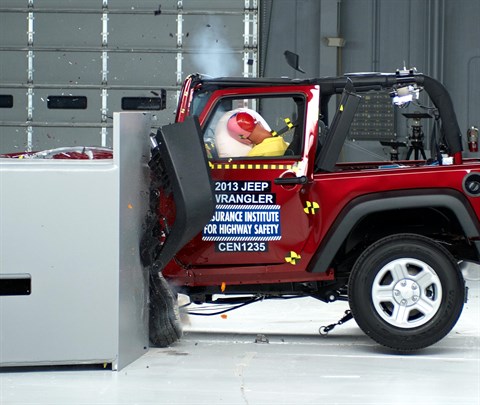
Action shot taken during the small overlap frontal crash test.

The dummy's position in relation to the door frame, steering wheel, and instrument panel after the crash test indicates that the driver's survival space was maintained reasonably well.
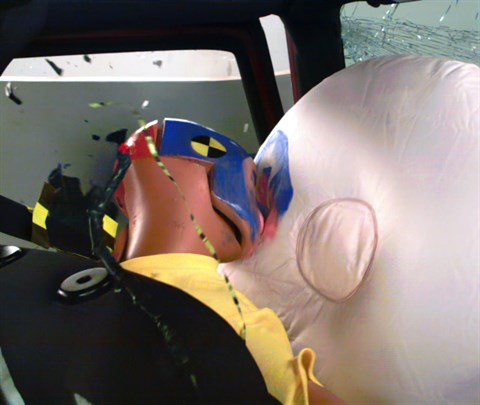
The dummy’s movement was well controlled. The dummy’s head loaded the frontal airbag, which stayed in front of the dummy until rebound. However, the vehicle lacks standard side airbags to protect the head and chest from contact with side structure and outside objects.
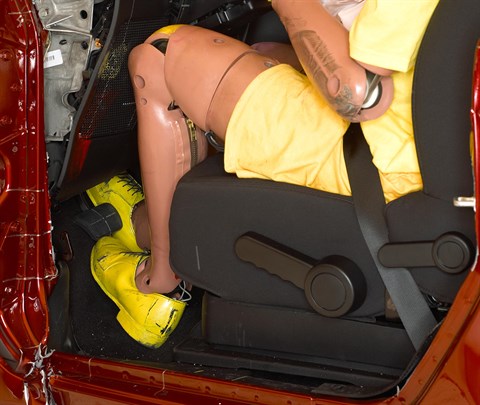
Intrusion of the instrument panel and footwell was sufficient to contribute to a high risk of injuries to the left knee, both thighs, and the left lower leg and a moderate risk of injury to the left foot.
Measures of occupant compartment intrusion on driver side
| Test ID | CEN1235 |
|---|---|
| Lower occupant compartment | |
| Lower hinge pillar max (cm) | 9 |
| Footrest (cm) | 17 |
| Left toepan (cm) | 16 |
| Brake pedal (cm) | 13 |
| Parking brake (cm) | |
| Rocker panel lateral average (cm) | 1 |
| Upper occupant compartment | |
| Steering column | 8 |
| Upper hinge pillar max (cm) | 9 |
| Upper dash (cm) | 11 |
| Lower instrument panel (cm) | 9 |
Driver injury measures
| Test ID | CEN1235 |
|---|---|
| Head | |
| HIC-15 | 147 |
| Peak gs at hard contact | no contact |
| Neck | |
| Tension (kN) | 1.6 |
| Extension bending moment (Nm) | 15 |
| Maximum Nij | 0.29 |
| Chest maximum compression (mm) | 31 |
| Femur (kN) | |
| Left | 13.0 |
| Right | 12.0 |
| Knee displacement (mm) | |
| Left | 26 |
| Right | 2 |
| Knee-thigh-hip injury risk (%) | |
| Left | 70 |
| Right | 60 |
| Maximum tibia index | |
| Left | 2.43 |
| Right | 0.61 |
| Tibia axial force (kN) | |
| Left | 2.1 |
| Right | 4.0 |
| Foot acceleration (g) | |
| Left | 177 |
| Right | 103 |
Moderate overlap front: original test
Rating applies to 2007-17 models
Tested vehicle: 2007 Jeep Wrangler X 2-door 4wd
The Jeep Wrangler was redesigned for the 2007 model year. A larger, heavier 4-door model was added for the first time, but the front ends of the 4-door and 2-door are very similar. For the 2018 model year only, the Wrangler was renamed the Wrangler JK, because the JK was built concurrently through much of the same model year as the redesigned 2018 Wrangler.
The Institute tested the 4-door Wrangler first, which received a Good overall frontal crash test rating. Therefore, frontal ratings for the 2-door are assigned by the Institute based on a test conducted by Chrysler. These ratings apply only to the 2007-17 Wrangler and 2018 Wrangler JK.
| Overall evaluation | |
|---|---|
| Structure and safety cage | |
| Driver injury measures | |
| Head/neck | |
| Chest | |
| Leg/foot, left | |
| Leg/foot, right | |
| Driver restraints and dummy kinematics |
Measures of occupant compartment intrusion on driver side
| Test ID | VTF0808 |
|---|---|
| Footwell intrusion | |
| Footrest (cm) | 4 |
| Left (cm) | 6 |
| Center (cm) | 8 |
| Right (cm) | 8 |
| Brake pedal (cm) | 3 |
| Instrument panel rearward movement | |
| Left (cm) | -1 |
| Right (cm) | 1 |
| Steering column movement | |
| Upward (cm) | 1 |
| Rearward (cm) | 0 |
| A-pillar rearward movement (cm) | 1 |
Driver injury measures
| Test ID | VTF0808 |
|---|---|
| Head | |
| HIC-15 | 215 |
| Peak gs at hard contact | 76 |
| Neck | |
| Tension (kN) | 1.2 |
| Extension bending moment (Nm) | 40 |
| Maximum Nij | 0.33 |
| Chest maximum compression (mm) | 37 |
| Legs | |
| Femur force - left (kN) | 5.9 |
| Femur force - right (kN) | 1.7 |
| Knee displacement - left (mm) | 2 |
| Knee displacement - right (mm) | 0 |
| Maximum tibia index - left | 0.63 |
| Maximum tibia index - right | 0.55 |
| Tibia axial force - left (kN) | 1.4 |
| Tibia axial force - right (kN) | 2.3 |
| Foot acceleration (g) | |
| Left | 76 |
| Right | 71 |
Side: original test
Rating applies to 2007-17 models
Tested vehicle: 2008 Jeep Wrangler Sahara 2-door 4wd without optional side airbags
The Jeep Wrangler was redesigned for the 2007 model year. For the 2018 model year only, the Wrangler was renamed the Wrangler JK, because the JK was built concurrently through much of the same model year as the redesigned 2018 Wrangler. These ratings apply only to the 2007-17 Wrangler and 2018 Wrangler JK.
During the crash, the driver door opened. This opening didn't significantly affect dummy movement during the test but shouldn't happen because, in some crashes, it could allow partial or complete occupant ejection, especially if the occupant is unbelted. This door opening resulted in a structure rating downgrade from good to acceptable.
| Overall evaluation | |
|---|---|
| Structure and safety cage | |
| Driver injury measures | |
| Head/neck | |
| Torso | |
| Pelvis/leg | |
|
Driver head protection
Although the intruding barrier did not hit the dummy's head in this test, the head was not protected from contacts outside the vehicle. This indicates that only slightly different crash circumstances could produce a direct hit to a person's head. | |
| Rear passenger injury measures | |
| Head/neck | |
| Torso | |
| Pelvis/leg | |
|
Rear passenger head protection
The dummy's head was hit by the diagonal steel tube supporting the convertible top. This impact did not produce high head injury measures, but the head protection is inadequate. | |
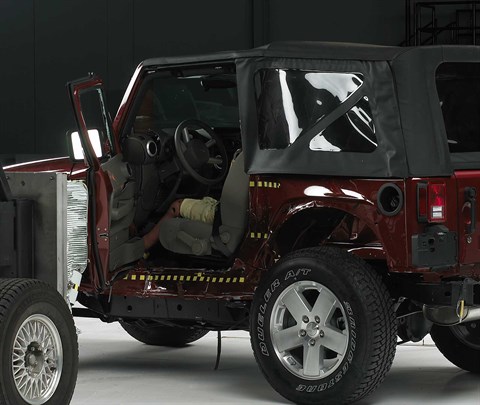
View of the vehicle and barrier just after the crash test, showing the open driver door.

View of the vehicle after the crash with door removed, showing damage to the occupant compartment.
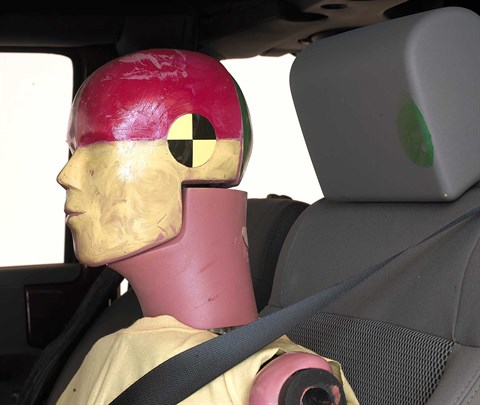
Although the dummy's head was not hit by the barrier, shattering glass from the side window left deep gouges on the top of the head.
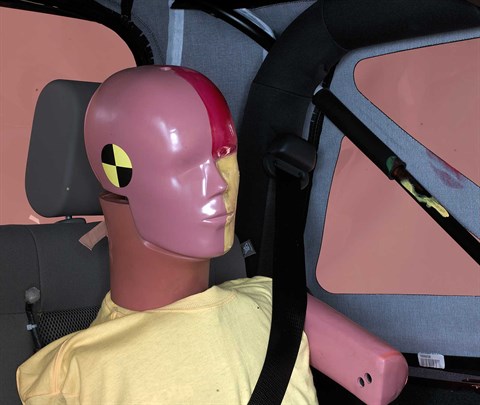
Smeared greasepaint shows where the rear passenger dummy's head was hit by the diagonal steel tube supporting the convertible top.
Measures of occupant compartment intrusion on driver side
| Test ID | CES0822 |
|---|---|
| B-pillar to longitudinal centerline of driver's seat (cm) | -15.5 |
| Negative numbers indicate the amount by which the crush stopped short of the seat centerline. | |
Driver injury measures
| Test ID | CES0822 |
|---|---|
| Head HIC-15 | 121 |
| Neck | |
| Tension (kN) | 1.5 |
| Compression (kN) | 0.1 |
| Shoulder | |
| Lateral deflection (mm) | 46 |
| Lateral force (kN) | 2.7 |
| Torso | |
| Maximum deflection (mm) | 57 |
| Average deflection (mm) | 49 |
| Maximum deflection rate (m/s) | 7.68 |
| Maximum viscous criterion (m/s) | 1.49 |
| Pelvis | |
| Iliac force (kN) | 2.8 |
| Acetabulum force (kN) | 3.6 |
| Combined force (kN) | 6.3 |
| Left femur | |
| L-M force (kN) | 0.4 |
| L-M moment (Nm) | 76 |
| A-P moment (Nm) | 39 |
Passenger injury measures
| Test ID | CES0822 |
|---|---|
| Head HIC-15 | 522 |
| Neck | |
| Tension (kN) | 1.6 |
| Compression (kN) | 0.1 |
| Shoulder | |
| Lateral deflection (mm) | 11 |
| Lateral force (kN) | 0.7 |
| Torso | |
| Maximum deflection (mm) | 24 |
| Average deflection (mm) | 8 |
| Maximum deflection rate (m/s) | 1.78 |
| Maximum viscous criterion (m/s) | 0.19 |
| Pelvis | |
| Iliac force (kN) | 1.5 |
| Acetabulum force (kN) | 2.1 |
| Combined force (kN) | 2.8 |
| Left femur | |
| L-M force (kN) | 0.8 |
| L-M moment (Nm) | 161 |
| A-P moment (Nm) | -90 |
Headlights
Ratings are given for 2 different headlight variations available on this vehicle.
Trim level(s)
- Sahara trim
- Rubicon trim
- 75th Anniversary Edition trim
- Winter trim
- Rubicon Hard Rock trim
- Chief trim
- Smokey Mountain trim
- Sport trim equipped with LED Lighting Group package
- Rubicon Recon trim
| Low-beam headlight type | LED reflector |
|---|---|
| High-beam headlight type | LED reflector |
| Curve-adaptive? | No |
| High-beam assist? | No |
|
Overall rating | |
| Distance at which headlights provide at least 5 lux illumination: | |
Low beams
On the straightaway, visibility was inadequate on both sides of the road. On curves, visibility was inadequate in all 4 tests.
The low beams never exceeded glare limits.
High beams
On the straightaway, visibility was good on the right side of the road and fair on the left side. On curves, visibility was inadequate in all 4 tests.
| Trim level(s) |
|
|---|---|
| Low-beam headlight type | LED reflector |
| High-beam headlight type | LED reflector |
| Curve-adaptive? | No |
| High-beam assist? | No |
|
Overall rating Applies to 2017 models |
| LOW BEAMS | Average minimum useful illumination distance (5 lux) |
Amount glare exceeded threshold |
|---|---|---|
| Straightaway right edge | 71.7 m | None |
| Straightaway left edge | 44.0 m | None |
| 250m radius right curve, right edge | 46.3 m | None |
| 250m radius left curve, left edge | 44.3 m | None |
| 150m radius right curve, right edge | 39.6 m | None |
| 150m radius left curve, left edge | 41.0 m | None |
| HIGH BEAMS | Average minimum useful illumination distance (5 lux) |
|---|---|
| Straightaway right edge | 146.9 m |
| Straightaway left edge | 136.4 m |
| 250m radius right curve, right edge | 58.6 m |
| 250m radius left curve, left edge | 55.6 m |
| 150m radius right curve, right edge | 46.2 m |
| 150m radius left curve, left edge | 46.6 m |
Trim level(s)
- Sport trim
- Sport S trim
- Willys Wheeler trim
- Freedom Edition trim
- Willys Wheeler W trim
- Big Bear trim
| Low-beam headlight type | Halogen reflector |
|---|---|
| High-beam headlight type | Halogen reflector |
| Curve-adaptive? | No |
| High-beam assist? | No |
|
Overall rating | |
| Distance at which headlights provide at least 5 lux illumination: | |
Low beams
On the straightaway, visibility was fair on the left side of the road and inadequate on the right side. On curves, visibility was inadequate in all 4 tests.
The low beams created some glare.
High beams
On the straightaway, visibility was inadequate on both sides of the road. On curves, visibility was inadequate in all 4 tests.
| Trim level(s) |
|
|---|---|
| Low-beam headlight type | Halogen reflector |
| High-beam headlight type | Halogen reflector |
| Curve-adaptive? | No |
| High-beam assist? | No |
|
Overall rating Applies to 2016-17 models |
| LOW BEAMS | Average minimum useful illumination distance (5 lux) |
Amount glare exceeded threshold |
|---|---|---|
| Straightaway right edge | 71.4 m | 4.5% |
| Straightaway left edge | 47.2 m | 4.5% |
| 250m radius right curve, right edge | 50.0 m | None |
| 250m radius left curve, left edge | 43.8 m | None |
| 150m radius right curve, right edge | 44.3 m | None |
| 150m radius left curve, left edge | 36.9 m | None |
| HIGH BEAMS | Average minimum useful illumination distance (5 lux) |
|---|---|
| Straightaway right edge | 93.3 m |
| Straightaway left edge | 38.5 m |
| 250m radius right curve, right edge | 50.0 m |
| 250m radius left curve, left edge | 40.5 m |
| 150m radius right curve, right edge | 42.7 m |
| 150m radius left curve, left edge | 35.6 m |
Child seat anchors
Rating applies to 2016-17 models
| Overall evaluation | |
| Vehicle trim | Sport |
| Seat type | cloth |
This vehicle has 2 rear seating positions with complete child seat attachment (LATCH) hardware.
| Overall evaluation | |
| Vehicle trim | Sport |
| Seat type | cloth |
| G | Good |
| A | Acceptable |
| M | Marginal |
| P | Poor |
| Seating positions that rely on borrowed lower anchors or have only a tether anchor available are not rated. | |
thether anchor symbol | Tether anchor |
lower anchor symbol | Lower anchors |
| Lower anchor(s) can be borrowed from adjacent positions(s) | |
| No hardware available |
Details by seating position
| 1 | |
|---|---|
| Tether anchor | |
| hard-to-find location | |
| other hardware could be confused for anchor | |
| Lower anchors | |
| too deep in seat | |
| not too much force needed to attach | |
| easy to maneuver around anchors | |
| 3 | |
| Tether anchor | |
| hard-to-find location | |
| other hardware could be confused for anchor | |
| Lower anchors | |
| too deep in seat | |
| not too much force needed to attach | |
| easy to maneuver around anchors |
Seat position 21
| Lower anchor A | |
|---|---|
| Open access rated | No |
| Depth (cm) | 2-4 |
| Force (lbs) | 18 |
| Clearance angle (degrees) | 62 |
| Lower anchor B | |
| Open access rated | No |
| Depth (cm) | 2-4 |
| Force (lbs) | 16 |
| Clearance angle (degrees) | 72 |
| Tether anchor | |
| Location | Bottom seatback |
| Confusing hardware present | Yes |
| Has contrasting label within 3 inches of tether anchor |
No |
| Tether anchors can be accessed while seatback is properly positioned for use of LATCH |
Not measured |
Seat position 23
| Lower anchor A | |
|---|---|
| Open access rated | No |
| Depth (cm) | 2-4 |
| Force (lbs) | 11 |
| Clearance angle (degrees) | 68 |
| Lower anchor B | |
| Open access rated | No |
| Depth (cm) | 2-4 |
| Force (lbs) | 13 |
| Clearance angle (degrees) | 75 |
| Tether anchor | |
| Location | Bottom seatback |
| Confusing hardware present | Yes |
| Has contrasting label within 3 inches of tether anchor |
No |
| Tether anchors can be accessed while seatback is properly positioned for use of LATCH |
Not measured |
